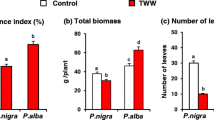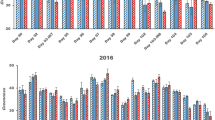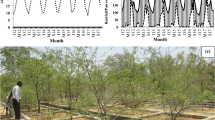Abstract
Lebanon is experiencing increased water shortages with a sharp rise in water demand and recurrent hydrological droughts. Of all the national economic sectors, agriculture utilizes the largest share (70%) of the available water. Irrigation with treated wastewater (TWW) could be a sustainable option for additional, non-conventional water resources. In this context, juvenile plants of two agroforestry species (Pinus pinea L. and Castanea sativa Mill.) were grown under a shaded frame. Primary (T1), secondary (T2) and tertiary (T3) TWWs were used for the irrigation of these nursery plants. Primary TWW is not recommended for reuse but was included for comparative purposes only. The control (C) consisted of irrigation with well water. After 14 months of treatment, the primary TWW caused an increase in height of 17% for pine and 22% for chestnut. Dry matter production increased significantly in T2 as compared to the control: by 81% in pine against 61% in chestnut. In addition, leaf area of sweet chestnut increased by 33% in T1 only. Overall, the response of chestnut was slower than that of stone pine. Among the three macronutrients, nitrogen was the most different between effluents, with the highest concentration found in primary TWW. By the end of the trial, the plants had been provided with 600 mm of water enriched with nutrients, essentially nitrogen. Pine plants treated with T2 had received 10 g of mineral N and accumulated 1.5 g N plant−1. The build-up of N in plants treated with T3 was 1.4 times lower in pine and 2.7 times lower in chestnut compared to the corresponding plants treated with T1. Pine plants receiving TWW had twice as much potassium as their control, while it increased by 3.6 times for chestnut. Phosphorus build-up did not differ between the pine plants, whereas for chestnut, those grown in T1 and T2 accumulated more P than the control. By the end of the work, no increase in salinity, sodicity hazards, nor critical fecal coliform levels were detected in the soil. Controlled reuse of secondary TWW can be considered a safe practice, notably in East Mediterranean soils with poor N contents.




Similar content being viewed by others
Data availability
The datasets generated during an/or analysed during the current study are available from the corresponding author on reasonable request.
References
Barbagallo S, Cirelli GL, Consoli S, Liciardello F, Marzo A, Toscano A (2012) Analysis of treated wastewater reuse potential for irrigation in Sicily. Water Sci Technol 65(11):2024–2033. https://doi.org/10.2166/wst2012.102
Borghesi S, Ticci E (2019) Climate change in the MENA region: environmental risks, socioeconomic effects and policy challenges for the future. IEMed Mediterranean yearbook 2019. IEMed, Barcelona
Drechsel P, Qadir M, Galibourg G (2022) The WHO guidelines for safe wastewater use in agriculture: a review of implementation challenges and possible solutions in the global south. Water 14:864. https://doi.org/10.3390/w14060864
Edokpayi JN, Odiyo JO, Durowoju OS (2017) Impact of wastewaert on surface water quality in develo** countries: a case study of South Afria. In: Tutu H (ed) Water quality. InTechOpen, London. https://doi.org/10.5772/66561
Estefan G, Sommer R, Ryan J (2013) Methods of soil, plant and water analysis: a manual for the West Asia and North Africa region, 3rd edn. ICARDA, Beirut
FAO (2015) FAO agriculture wastewater fact sheet. FAO, Rome. https://www.fao.org/nr/water. Accessed Sept 2022.
Feitosa EO, Lopes FB, Andrade EM, Magalhães ACM, Freitas CAS (2019) Production indicators in cowpea as a function of the water–fertiliser nexus. Agronomy 9(11):691. https://doi.org/10.3390/agronomy9110691
ESCWA (2017) Wastewater An arab perspective. E/ESCWA/SDPD/2017/Booklet.1. page 13. https://www.unescwa.org. Accessed 15 Mar 2023
Gao Y, Shao G, Wu S, **aojun W, Lu J, Cui J (2021) Changes in soil salinity under treated wastewater irrigation: a meta-analysis. Agric Water Manag 255:106986. https://doi.org/10.1016/j.agwat.2021.106986
Halwani J, Halwani B (2022) Climate change in Lebanon and the impact to water resources. In: Leal Filho W, Manolaas E (eds) Climate change in the Mediterranean and Middle Eastern countries, climate change management. Springer Nature Switzerland, Cham, pp 395–412. https://doi.org/10.1007/978-3-03-78566-6_1
Hashem MS, Qi X-B (2021) Treated wastewater irrigation—a review. Water 13:1527. https://doi.org/10.3390/w13111527
IDAL (Investment Development Authority of Lebanon) (2017) Agriculture sector—2017 factsheet. IDAL, Beirut
Karam F, Mouneime AH, El-Ali F, Mordovanaki G, Rouphael Y (2013) Wastewater management and reuse in Lebanon. J Appl Res 9(4):2868–2879
Laroche A, Freyssac V, Rahmani A, Verger JP, Morvan H (1997) Growth and mineral content of young chestnut trees under controlled conditions of nutrition. Ann For Sci 54(7):681–693
Maquet C (2020) Wastewater reuse: a solution with a future. Field Actions Sci Rep 22:64–69
Masri T, Nuwayhid RY, Masri N, Fakhry K (2009) Autoecology of Castanea sativa in Lebanon. Acta Hortic. https://doi.org/10.17660/ActaHortic.2009.815.11
Mcheik M, Toufaily J, Haj Hassan B, Hamieh T, Abi Saab M-T, Rouphael Y, Ferracin E, Da Shio B, Bashabshah I, Al-Hadidi L (2017) Reuse of treated municipal wastewater in irrigation: a case study from Lebanon and Jordan. Water Environ J 31(4):552–558
Mcheik M, Toufaily J, Akil M, Hamieh T, Abi Saab M-T, Haj Hassan B, Rouphael Y (2018) Reuse of treated municipal wastewater under different growing seasons for the spinach production. Am J Anal Chem 9:482–499
Nakhoul J, Fernandez C, Bousquet-Mélou A, Nemer N, Abboud J, Prévosto B (2020) Vegetation dynamics and regeneration of Pinus pinea forests in Mount Lebanon: towards the progressive disappearance of pine. Ecol Eng. https://doi.org/10.1016/j.ecoleng.2020.105866
Petousi I, Daskalakis G, Fountoulakis MS, Lydakis D, Fletchr L, Stentiford EI, Manios T (2019) Effects of teated wastewater irrigation on the establishment of young grapevines. Sci Total Environ 658:485–492
Prescott LM, Harley JP, Klein DA (2003) Microbiologie, 2nd edn. De Boeck & Larcier s.a., Brussels
Ribeiro SL, Fonseca TF, Pires AL (2019) Influence of fertilization on growth of young chestnut trees (Castanea sativa Mill.) managed for wood production. Cerne 25(4):357–364
Rodier J (1996) Analyse de l’eau, 8th edn. Dunod, Paris, p 1396
Sahour H, Vazifehdan M, Alsheri F (2020) Aridity trend in the Middle east and the adjacent areas. Theor Appl Climatol. https://doi.org/10.20944/preprints202003.0225.v1
Shaban A (2011) Analyzing climatic and hydrologic trends in Lebanon. J Environ Sci Eng 5:483–492
Shaban A (2020) Water resources of Lebanon. World Water Resour. https://doi.org/10.1007/978-3-030-48717-1
Weather Atlas (2022) Climate and monthly weather forecast Hammana, Lebanon. https://www.weather-atlas.com/en/lebanon/hammana-climate. Accessed 14 Sept 2022
WHO (2006) Guidelines for the safe use of wastewater excreta and grey water. Volume 2: Wastewater use in agriculture. World Health Organization, Geneva
Worldometer (2022) Lebanon population. https://www.worldometers.info/world-population/lebanon-population. Accessed 14 Sept 2022
WWAP (United Nations World Water Assessment Programme) (2017) The United Nations world water development report 2017. Wastewater: the untapped resource. UNESCO, Paris
Acknowledgements
This work recived financial support from the Lebanese National Council for Scientific Research.
Author information
Authors and Affiliations
Corresponding author
Additional information
Responsible Editor: Mohamed Ksibi.
Rights and permissions
Springer Nature or its licensor (e.g. a society or other partner) holds exclusive rights to this article under a publishing agreement with the author(s) or other rightsholder(s); author self-archiving of the accepted manuscript version of this article is solely governed by the terms of such publishing agreement and applicable law.
About this article
Cite this article
Mouneimne, A.H., Atallah, T., Halwani, J. et al. Impact of treated wastewater on the performance of young plants of stone pine (Pinus pinea L.) and sweet chestnut (Castanea sativa Mill.) under semi-controlled Mediterranean conditions. Euro-Mediterr J Environ Integr 8, 143–151 (2023). https://doi.org/10.1007/s41207-023-00352-8
Received:
Accepted:
Published:
Issue Date:
DOI: https://doi.org/10.1007/s41207-023-00352-8




